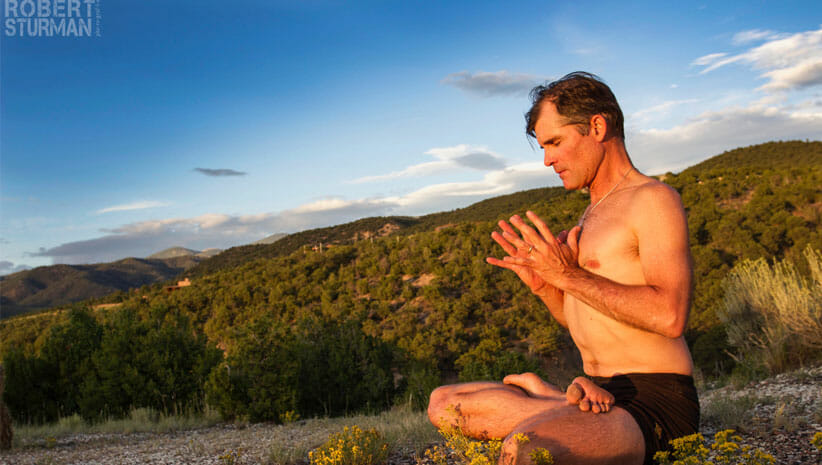
Tias Little photographed by Robert Sturman
Everyone is into the core these days. We build the core, activate the core, power up the core. We look for ways to develop real core strength. Yet what in the body really comprises the core? Is the core the spine, the iliopsoas muscle or the perineal fibers associated with mula bandha? I would like to propose that the bones are our innermost core tissues.
In all of the internal arts including Tai Chi, Qigong, or Yoga, the bones are a source of longevity and lasting wisdom. In the ancestral teachings from Tibet, India, and China, the bones were believed to be invested with enduring power.
For instance, in Tantra rituals, the femur and skull cap were used as implements to increase yogic power. In early Greek culture, the sacrum was believed to be the one bone in the body that never decomposed and that the soul incarnated from the holy bone of the sacrum.
In Sanskrit, bone is called asthi. This is easy to remember because the word asthi shares a common root with the Greek word for bone osteon. In this light, you can think of your bone doctor as your “asthiopath”! In Ayurveda, bone is directly linked to the nerves. In Yoga, the more we settle into our bones the more stable and equanimous our nervous system.
In Chinese Medicine, living bone is the source of the body’s essential vitality. In Traditional Chinese Medicine (TCM) and Qigong it is held that bone stores jing, the deepest life force in the body. Jing is related to blood and reproductive fluid. It is the most subtle, fine, and potent of all bodily substances.
In Qigong, standing meditation is paramount to the cultivation and preservation of jing. When standing for long periods of time (such as in the Horse Stance) the bones are amplified and jing is concentrated in the bones.
Standing poses in Yoga also help to build resiliency and real core strength in the bony matrix. Yet to do so it is critical to remain in the standing position for two to three minutes. This can be done without strain in poses such as mountain pose, half-moon pose, or utkatasana.
The heart of the bone is the marrow. Bone marrow is the innermost fluid within the body. In TCM, bone marrow is linked to the jing and in Ayurveda it is linked to ojas, the life force relating to immunity and reproductive power. Marrow is the source of prana. If we consider that prana is blood (namely as oxygen) then prana is to a great extent born out of the bone. Bone is continuously generating blood. Your bone marrow has produced approximately 200 billion blood cells just today!
Red blood cells and white blood cells along with platelets and lymph cells are secreted from the bone into circulation via numerous tributaries of artery inside the bone. Consider that your bones are your virtual blood banks.
The sponge-like interior of bone is both resilient and adaptable. In somatic practices, bones shape shift over time. One can reshape the contours of bone by mobilizing the surrounding connective tissues. Bone receives approximately ten percent of all of the blood pumped from the heart. Thus, it is not outlandish to say that we breathe into our bones! Bones are more vascular than cartilage and thus, unlike cartilage, bones are being remodeled and reformed continuously.
As people age (especially women), the vascular supply to the bone wanes. For this reason, women are more prone to osteoporosis, wherein the bone’s capacity to rebuild its own tissue is compromised. By positively stressing the bone (for example standing on one leg in warrior 3), we support circulation into the bone and help increase bone density.
If we look at the bones from the point of view of the elements, the bones are comparable to the earth. The bones are the ground of our being. This makes sense in light of the fact that bone is a storehouse of minerals, namely calcium, but also salt, magnesium, and phosphorus. The mineral deposits in bone are largely overseen by the throat chakra, namely the parathyroid gland within the throat. The parathyroid governs levels of calcium in the bone. You can experiment with generating vocalized resonance (like the OM sound) and sensing the vibration into your bones.
Our bones are encased by a silvery layer of connective tissue called periosteum. If you have ever pulled chicken flesh off the bone, you have likely seen a thin membrane of tissue that envelopes the bone. Periosteum is one of the deepest connective tissues in the body. Ligaments, tendons, and muscles attach into the periosteum in order to pull on the bone. Ligaments hold bone to bone. The tension held in the ligaments determines, at the deepest level, our characteristic shape. When you stretch in a pose, you can sense the continuity of fascia from your musculature, through your tendons, to the surface of your bone.
Bones are not static and rigid struts. Rather they are dynamic living tissue that are being continuously reconstructed. When I teach savasana or Yoga Nidra, I encourage students to sense the living presence of their bones. When we drop our bones into the ground, we experience a profound sense of stillness. We release our core tissues including the ligaments, tendons and joint capsules. The next time you are in savasana, listen to your bones. Sense their weight, gravity, and mass. At the same time sense their fluidity and aliveness. Sense the way your innermost core structures settle deeply into earth.
